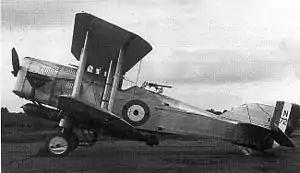Handley Page Hendon
The Handley Page Hendon was a British torpedo bomber of the 1920s. A two-seat development of Handley Page's earlier single-seat Hanley, the Hendon was a single-engine biplane. While six aircraft were purchased by the British Air Ministry for evaluation and trials purposes, no further production ensued and the Hendon did not enter squadron service.
| Hendon | |
|---|---|
 | |
| Role | Torpedo bomber |
| National origin | United Kingdom |
| Manufacturer | Handley Page |
| First flight | 1924 |
| Retired | 1927 |
| Status | Prototypes |
| Number built | 6 |
| Developed from | Handley Page Hanley |
Development and design
While the single-seat Handley Page Hanley had lost to the similar Blackburn Dart in fulfilling the requirements for a carrier-based torpedo bomber to equip Britain's Fleet Air Arm, it was recognised by both Handley Page and the Air Ministry that a two-seat aircraft would be more useful both for operational purposes and for experimental work. An order was therefore placed on 27 November 1923 for six two-seat derivatives of the Hanley III, designated the Type Ta (later known as the H.P.25) or Handley Page Hendon to meet the requirements of Air Ministry Specification 25/23 for an interim torpedo bomber.[1]
The first of the six aircraft to fly, (serial N9724) flew on 7 July 1924, with the remaining five flying by September. It had a longer fuselage to accommodate the observer, who was provided with a .303 in (7.7 mm) Lewis Gun on a Scarff ring mounting, but initially, was similar to the Hanley III. Tests showed that it was tailheavy when carrying a torpedo, the outer wings being swept back by six degrees to avoid this.[2]
Operational history
The six Hendons were used for extensive trials to investigate various configurations of leading edge slots/slats. These allowed one aircraft to successfully land on HMS Furious while carrying a torpedo and without using arrestor gear.[3] No further production occurred, the development of automatic slots in October 1927 making the Hendon obsolete.
Variants
- Hendon I
- Initial configuration. Leading edge slots as Hanley III. Six built.
- Hendon II
- Improved slot gear. Three converted.
- Hendon III
- Slotted Flaps. One converted from Hendon II.
Specifications (Hendon)
Data from Handley Page Aircraft since 1907.[4]
General characteristics
- Crew: 2
- Length: 36 ft 6 in (11.13 m)
- Wingspan: 46 ft 0 in (14.02 m)
- Height: 13 ft 8 in (4.17 m)
- Wing area: 562 sq ft (52.2 m2)
- Empty weight: 4,350 lb (1,973 kg) [5]
- Gross weight: 6,970 lb (3,162 kg)
- Powerplant: 2 × Napier Lion IIB W-12 water-cooled piston engine, 450 hp (340 kW) each
- Propellers: 2-bladed fixed-pitch propeller
Performance
- Maximum speed: 110 mph (180 km/h, 96 kn)
- Stall speed: 55 mph (89 km/h, 48 kn)
- Service ceiling: 9,500 ft (2,900 m)
- Wing loading: 12.4 lb/sq ft (61 kg/m2)
- Power/mass: 0.065 hp/lb (0.107 kW/kg)
Armament
- Guns: 1 × .303 in (7.7 mm) forward firing Vickers machine gun and 1 × .303 in (7.7 mm) Lewis gun in rear cockpit
- Bombs: 1 × 18 in (457 mm) torpedo or 2 × 230 lb (105 kg) bombs
See also
Related development
Aircraft of comparable role, configuration, and era
References
Notes
- Barnes 1976, p.223, 225.
- Barnes 1976, p.225.
- Mason 1994, p.158.
- Barnes 1976, p.229.
- Lewis 1980, p.420-421.
Bibliography
- Barnes, C.H. Handley Page Aircraft since 1907. London:Putnam, 1976. ISBN 0-370-00030-7.
- Mason, Francis K. The British Bomber since 1914. London:Putnam, 1994. ISBN 0-85177-861-5.
- Lewis, Peter. The British Bomber since 1914. London:Putnam, Third edition, 1980. ISBN 0-370-30265-6.
- "The Handley Page “Hendon”". Flight. 29 July 1926. Page 459–461.